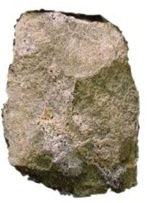
Grain size: Fine to very fine.
Texture: Frequently shows altering layers that differ slightly in granularity or colour. Phenocrysts not uncommon (porphyritic rhyolite). Flow banding is sometimes evident, defined by swirling layers of differing colour or granularity, and by aligned phenocrysts.
Structure: Vesicles or amygdales may be present. (Pumice is a highly vesicular variety of rhyolite.) May contain spherulites which are spherical bodies, often coalescing, comprising radial aggregates of needles, usually of quartz or feldspar. Spherulites are generally less than 0,5 cm in diameter, but they may reach a meter or more across. They form by very rapid growth in quickly cooling magma, and the crystallization of glass. Mineralogy: As for granite, but rapid cooling results in minute crystals. Phenocrysts of quartz, feldspar, hornblende or mica occur.
Field relations: Flows, dykes and plugs. Rhyolite (or granite) magma is highly viscous and so flows only very slowly, so that if it is extruded it forms very short, thick flows or is confined as a plug in the throat of a volcano." (Hamilton et al 1976, 164)
rhyolite tool
